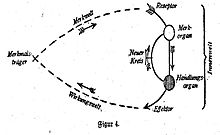
Back Món perceptiu Catalan Umwelt German Omailm Estonian Umwelt French Umwelt Italian 環世界 Japanese 움벨트 Korean Milieu Dutch Umwelt Portuguese Умвельт Russian



In the semiotic theories of Jakob von Uexküll and Thomas Sebeok, umwelt (plural: umwelten; from the German Umwelt meaning "environment" or "surroundings") is the "biological foundations that lie at the very center of the study of both communication and signification in the human [and non-human] animal".[1][failed verification] The term is usually translated as "self-centered world".[2] Uexküll theorised that organisms can have different umwelten, even though they share the same environment. The term umwelt, together with companion terms Umgebung (an Umwelt as seen by another observer) and Innenwelt (the mapping of the self to the world of objects),[3] have special relevance for cognitive philosophers, roboticists and cyberneticians because they offer a potential solution to the conundrum of the infinite regress of the Cartesian Theater.
- ^ Sebeok, Thomas A. (1976). "Foreword". Contributions to the Doctrine of Signs. Lisse, Netherlands: Peter de Ridder Press. p. x. ISBN 0-87750-194-7.
- ^ Kull, Kalevi (2010). "Umwelt". In Cobley, Paul (ed.). The Routledge Companion to Semiotics. London: Routledge. pp. 348–349. ISBN 978-0-415-44072-1.
- ^ Cobley, Paul (2010). The Routledge Companion to Semiotics. London and New York: Routledge. p. 348.
© MMXXIII Rich X Search. We shall prevail. All rights reserved. Rich X Search